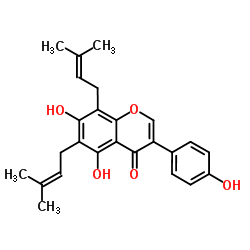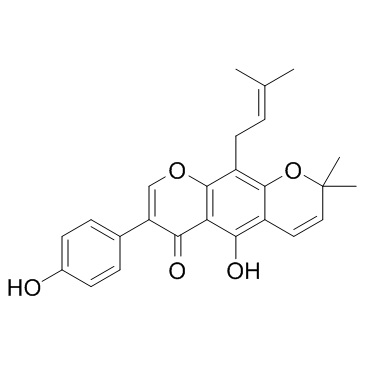482-53-1
| Name | osajin |
|---|---|
| Synonyms |
UNII-83R5N9X74B
5-Hydroxy-3-(4-hydroxyphenyl)-8,8-dimethyl-6-(3-methyl-2-butenyl)-4H,8H-benzo[1,2-b:3,4-b']dipyran-4-one 4H,8H-Benzo[1,2-b:3,4-b']dipyran-4-one, 5-hydroxy-3-(4-hydroxyphenyl)-8,8-dimethyl-6-(3-methyl-2-buten-1-yl)- 5-Hydroxy-3-(4-hydroxyphenyl)-8,8-dimethyl-6-(3-methyl-2-buten-1-yl)-4H,8H-pyrano[2,3-f]chromen-4-one osajin |
| Description | Osajin is the major bioactive isoflavone present in the fruit of Maclura pomifera with antitumor, antioxidant and anti-inflammatory activities. |
|---|---|
| Related Catalog | |
| Target |
Apoptosis[1] |
| In Vitro | Osajin significantly decreases the viability of human NPC cells (TW076, CG1 and TW04 cells) in a dose-dependent manner. Osajin induces apoptosis in human NPC cells through multiple apoptotic pathways, including the extrinsic death receptor pathway, and intrinsic pathways relying on mitochondria and endoplasmic reticulum stress[1]. Osajin exhibits growth inhibitory activity on six human cancer cell lines, including kidney, lung, prostate, breast, melanoma and colon cancer cells[2]. |
| In Vivo | Osajin and pomiferin attenuates the myocardial dysfunction provoked by ischemia reperfusion. This is confirmed by an increase in both antioxidant enzyme values and total antioxidant activity. The cardioprotection provided by osajin and pomiferin treatment results from the suppression of oxidative stress and this correlates with improved ventricular function[3]. |
| Cell Assay | NPC cells are seeded in 96-well plates (5000/well) and allowed to adhere for 24 h. The medium is then substituted by a fresh one containing different concentrations (0.01–10 µM) of osajin for another 24 h. For the time-course assay, the incubation times with 5 µM of osajin are 6, 12, 24, 36 and 48 h. After incubation, 10 µl of 5 mg/ml of MTT is added to each well and incubated for 4 h at 37°C. Cell viability is determined using the MTT-based assay[1]. |
| Animal Admin | Rats[1] The Wistar rats are divided into four groups. The first treatment group receives osajin (5 mg/kg/day in 0.5% Avicel); the second treatment group receives pomiferin (5 mg/kg/day in 0.5% Avicel); the placebo group receives only 0.5 Avicel; the last is an untreated control group. Biochemical indicator of oxidative damage-lipid peroxidation product malondialdehyde, antioxidant enzymes-superoxide dismutase, glutathione peroxidase, total antioxidant activity in serum and myocardium are evaluated. The effect of osajin and pomiferin on cardiac function, left ventricular end-diastolic pressure, left ventricular pressure and peak positive +dP/dt ischemia and reperfusion, also is examined[1]. |
| References |
| Density | 1.3±0.1 g/cm3 |
|---|---|
| Boiling Point | 632.3±55.0 °C at 760 mmHg |
| Melting Point | 189° (uncorr), 193° (corr) |
| Molecular Formula | C25H24O5 |
| Molecular Weight | 404.455 |
| Flash Point | 218.7±25.0 °C |
| Exact Mass | 404.162384 |
| PSA | 79.90000 |
| LogP | 7.62 |
| Vapour Pressure | 0.0±1.9 mmHg at 25°C |
| Index of Refraction | 1.628 |
| Storage condition | ?20°C |
|
SECTION 1: Identification of the substance/mixture and of the company/undertaking Product identifiers Product name: Osajin REACH No.: A registration number is not available for this substance as the substance or its uses are exempted from registration, the annual tonnage does not require a registration or the registration is envisaged for a later registration deadline.
CAS-No.: 482-53-1 Relevant identified uses of the substance or mixture and uses advised against Identified uses: Laboratory chemicals, Manufacture of substances SECTION 2: Hazards identification Classification of the substance or mixture Classification according to Regulation (EC) No 1272/2008 Acute aquatic toxicity (Category 1), H400 Chronic aquatic toxicity (Category 1), H410 For the full text of the H-Statements mentioned in this Section, see Section 16. Classification according to EU Directives 67/548/EEC or 1999/45/EC N Dangerous for theR50 environment For the full text of the R-phrases mentioned in this Section, see Section 16. Label elements Labelling according Regulation (EC) No 1272/2008 Pictogram Signal wordWarning Hazard statement(s) H410Very toxic to aquatic life with long lasting effects. Precautionary statement(s) P273Avoid release to the environment. P501Dispose of contents/ container to an approved waste disposal plant. Supplemental Hazardnone Statements Other hazards - none SECTION 3: Composition/information on ingredients Substances Molecular Weight: 404,46 g/mol CAS-No.: 482-53-1 Hazardous ingredients according to Regulation (EC) No 1272/2008 ComponentClassificationConcentration Osajin Aquatic Acute 1; Aquatic- Chronic 1; H410 Hazardous ingredients according to Directive 1999/45/EC ComponentClassificationConcentration Osajin N, R50- For the full text of the H-Statements and R-Phrases mentioned in this Section, see Section 16 SECTION 4: First aid measures Description of first aid measures General advice Consult a physician. Show this safety data sheet to the doctor in attendance. If inhaled If breathed in, move person into fresh air. If not breathing, give artificial respiration. Consult a physician. In case of skin contact Wash off with soap and plenty of water. Consult a physician. In case of eye contact Flush eyes with water as a precaution. If swallowed Never give anything by mouth to an unconscious person. Rinse mouth with water. Consult a physician. Most important symptoms and effects, both acute and delayed The most important known symptoms and effects are described in the labelling (see section 2.2) and/or in section 11 Indication of any immediate medical attention and special treatment needed no data available SECTION 5: Firefighting measures Extinguishing media Suitable extinguishing media Use water spray, alcohol-resistant foam, dry chemical or carbon dioxide. Special hazards arising from the substance or mixture no data available Advice for firefighters Wear self contained breathing apparatus for fire fighting if necessary. Further information no data available SECTION 6: Accidental release measures Personal precautions, protective equipment and emergency procedures Avoid dust formation. Avoid breathing vapours, mist or gas. Ensure adequate ventilation. For personal protection see section 8. Environmental precautions Prevent further leakage or spillage if safe to do so. Do not let product enter drains. Discharge into the environment must be avoided. Methods and materials for containment and cleaning up Pick up and arrange disposal without creating dust. Sweep up and shovel. Keep in suitable, closed containers for disposal. Reference to other sections For disposal see section 13. SECTION 7: Handling and storage Precautions for safe handling Provide appropriate exhaust ventilation at places where dust is formed. For precautions see section 2.2. Conditions for safe storage, including any incompatibilities Store in cool place. Keep container tightly closed in a dry and well-ventilated place. Recommended storage temperature: -20 °C Specific end use(s) A part from the uses mentioned in section 1.2 no other specific uses are stipulated SECTION 8: Exposure controls/personal protection Control parameters Components with workplace control parameters Exposure controls Appropriate engineering controls Handle in accordance with good industrial hygiene and safety practice. Wash hands before breaks and at the end of workday. Personal protective equipment Eye/face protection Use equipment for eye protection tested and approved under appropriate government standards such as NIOSH (US) or EN 166(EU). Skin protection Handle with gloves. Gloves must be inspected prior to use. Use proper glove removal technique (without touching glove's outer surface) to avoid skin contact with this product. Dispose of contaminated gloves after use in accordance with applicable laws and good laboratory practices. Wash and dry hands. The selected protective gloves have to satisfy the specifications of EU Directive 89/686/EEC and the standard EN 374 derived from it. Body Protection Choose body protection in relation to its type, to the concentration and amount of dangerous substances, and to the specific work-place., The type of protective equipment must be selected according to the concentration and amount of the dangerous substance at the specific workplace. Respiratory protection Respiratory protection is not required. Where protection from nuisance levels of dusts are desired, use type N95 (US) or type P1 (EN 143) dust masks. Use respirators and components tested and approved under appropriate government standards such as NIOSH (US) or CEN (EU). Control of environmental exposure Prevent further leakage or spillage if safe to do so. Do not let product enter drains. Discharge into the environment must be avoided. SECTION 9: Physical and chemical properties Information on basic physical and chemical properties a) AppearanceForm: solid b) Odourno data available c) Odour Thresholdno data available d) pHno data available e) Melting point/freezing194 °C point f) Initial boiling point and no data available boiling range g) Flash pointno data available h) Evapouration rateno data available i) Flammability (solid, gas) no data available j) Upper/lowerno data available flammability or explosive limits k) Vapour pressureno data available l) Vapour densityno data available m) Relative densityno data available n) Water solubilityno data available o) Partition coefficient: n- log Pow: 5,599 octanol/water p) Auto-ignitionno data available temperature q) Decompositionno data available temperature r) Viscosityno data available s) Explosive propertiesno data available t) Oxidizing propertiesno data available Other safety information no data available SECTION 10: Stability and reactivity Reactivity no data available Chemical stability Stable under recommended storage conditions. Possibility of hazardous reactions no data available Conditions to avoid no data available Incompatible materials Strong oxidizing agents Hazardous decomposition products Other decomposition products - no data available In the event of fire: see section 5 SECTION 11: Toxicological information Information on toxicological effects Acute toxicity no data available Skin corrosion/irritation no data available Serious eye damage/eye irritation no data available Respiratory or skin sensitisation no data available Germ cell mutagenicity no data available Carcinogenicity IARC:No component of this product present at levels greater than or equal to 0.1% is identified as probable, possible or confirmed human carcinogen by IARC. Reproductive toxicity no data available Specific target organ toxicity - single exposure no data available Specific target organ toxicity - repeated exposure no data available Aspiration hazard no data available Additional Information RTECS: Not available To the best of our knowledge, the chemical, physical, and toxicological properties have not been thoroughly investigated. SECTION 12: Ecological information Toxicity no data available Persistence and degradability no data available Bioaccumulative potential no data available Mobility in soil no data available Results of PBT and vPvB assessment PBT/vPvB assessment not available as chemical safety assessment not required/not conducted Other adverse effects Very toxic to aquatic life with long lasting effects. no data available SECTION 13: Disposal considerations Waste treatment methods Product Offer surplus and non-recyclable solutions to a licensed disposal company. Dissolve or mix the material with a combustible solvent and burn in a chemical incinerator equipped with an afterburner and scrubber. Contaminated packaging Dispose of as unused product. SECTION 14: Transport information UN number ADR/RID: 3077IMDG: 3077IATA: 3077 UN proper shipping name ADR/RID: ENVIRONMENTALLY HAZARDOUS SUBSTANCE, SOLID, N.O.S. (Osajin) IMDG: ENVIRONMENTALLY HAZARDOUS SUBSTANCE, SOLID, N.O.S. (Osajin) IATA:Environmentally hazardous substance, solid, n.o.s. (Osajin) Transport hazard class(es) ADR/RID: 9IMDG: 9IATA: 9 Packaging group ADR/RID: IIIIMDG: IIIIATA: III Environmental hazards ADR/RID: yesIMDG Marine pollutant: yesIATA: yes Special precautions for user Further information EHS-Mark required (ADR 2.2.9.1.10, IMDG code 2.10.3) for single packagings and combination packagings containing inner packagings with Dangerous Goods > 5L for liquids or > 5kg for solids. SECTION 15 - REGULATORY INFORMATION N/A SECTION 16 - ADDITIONAL INFORMATION N/A |
| Symbol |

GHS09 |
|---|---|
| Signal Word | Warning |
| Hazard Statements | H410 |
| Precautionary Statements | P273-P501 |
| Hazard Codes | N |
| Risk Phrases | 50 |
| Safety Phrases | 61 |
| RIDADR | UN 3077 9 / PGIII |
|
~% 
482-53-1 |
| Literature: Singhal, Ashok K.; Sharma, Ram P.; Thyagarajan, Gopalakrishna; Herz, Werner; Govindan, Serengolam V. Phytochemistry (Elsevier), 1980 , vol. 19, p. 929 - 934 |
| Precursor 1 | |
|---|---|
| DownStream 2 | |





![5-methoxy-3-(4-methoxyphenyl)-8,8-dimethyl-6-(3-methylbut-2-enyl)pyrano[2,3-h]chromen-4-one structure](https://image.chemsrc.com/caspic/443/5254-72-8.png)